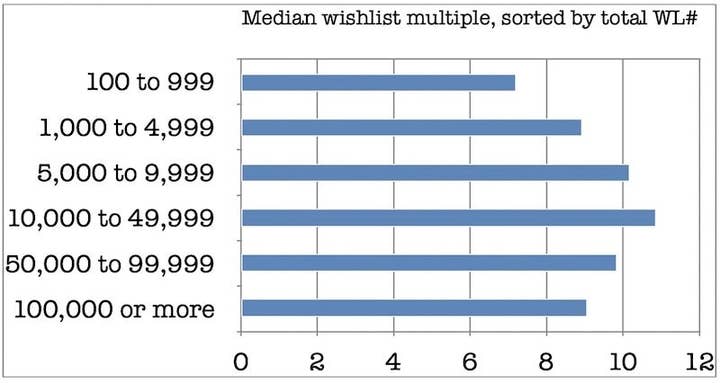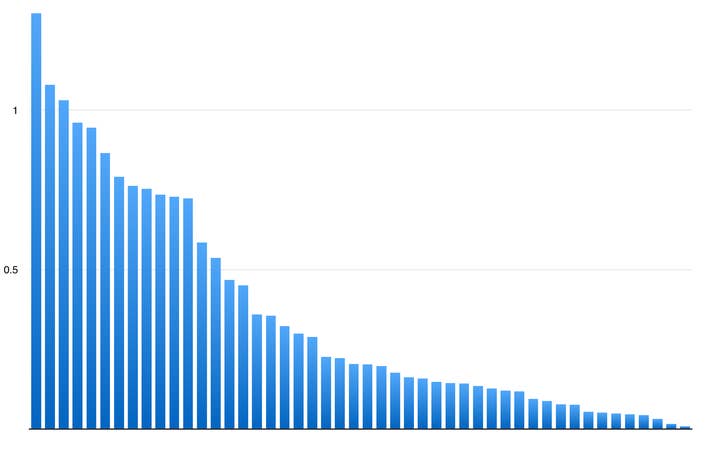Are Steam followers the best predictor of success for unreleased games?
GameDiscoverCo's Simon Carless examines how Steam festivals and showcases have changed the impact of being wishlisted
[The GameDiscoverCo game discovery newsletter is written by 'how people find your game' expert and GameDiscoverCo founder Simon Carless, and is a regular look at how people discover and buy video games in the 2020s.]
Recently, we decided to do a survey to examine how Steam wishlists relate to Steam followers. (We'll explain both in a second, for those who haven't been paying attention to Steam followers.)
Here's the good news - we got 113 valid responses about follower and wishlist counts from unreleased Steam games, giving us a pretty good cross-section to look at. (We're making the full data set available here, if anyone wants to try prettier visualizations, or extra insight.)
Just to remind you all, quoting from our call for data: "Steam followers are an always-public number, viewable for every released and unreleased Steam game. It's the amount of people who decided to see news and updates about your game without wishlisting it."
This is useful because you can't see how many wishlists other games have -- just a ranking if they're in the top 800. But you can see any game's follower numbers via the SteamDB page under 'Store Data', or various other more esoteric ways. So, followers are a great way to estimate deeper interest in a Steam game before it comes out.
Just reminding on the core difference between Steam wishlists and follows:
● Players who've wishlisted a game get an notification/email when the game is released, and every time it is discounted 20% or more. They only see game announcements in their news feeds after they purchase the game. (But they can obviously see game announcements by going to the Steam store page and reading them.)
● Players who followed a game see all pre- and post-release announcements about that game in the Steam news section and elsewhere. It's possible that people are more likely to follow Games-as-a-Service-style games that have substantive or important updates. (Or they just follow games because they are especially interested in them.)
This is why you see people suggesting you both 'follow and wishlist' their game. Following helps with the news feed visibility both pre- and post-release, whereas wishlisting is more 'we'll notify you when games you wishlist are available or on sale'. But it doesn't come with news feed visibility.
What's the new follower/wishlist ratio, then?
The generally perceived wisdom a while back was that followers x5 or x6 = wishlists. But this was before Steam gave you opportunities to showcase your game before release in Steam Festivals, publisher and sale features, and more. And that's a great thing, by the way. But it obviously changes those ratios.
And what our survey shows is that the vast majority of wishlists for unreleased Steam games are between 5x and 14x the followers, with an average of 9.64x and a median of 9.6x. Here's every single data point we gathered:

So that means an unreleased Steam game with 5,000 Steam followers, if it were a median performing title, would have 48,000 wishlists. But it could be as low as 25,000 wishlists or as high as 70,000 wishlists.
Interesting, huh? This was even a little higher than we estimated before fielding the survey. We thought it would be more like 6x - 10x, with an average of around 8x. Not so. So let's go a little deeper.
Getting granular with Steam Festivals/showcases & ratios!
So in addition to asking about your wishlist-to-follower ratio, we quizzed our survey respondents about whether they'd been in a Steam Festival, a pre-release showcase (publisher sale, themed sale, event sale), both, or neither. Here's the results for this:

Unsurprisingly, if you've been in neither, your wishlist multiple is 7.77x -- closer to the estimates previously given before these opportunities existed. But if you've been in a Steam Festival, your wishlist multiple is exactly 10x, and for both Steam Festival and a pre-release 'feature', your wishlist multiple is 10.45x.
(There are hardly any games who were in pre-release showcases but not a Steam Festival, so that slightly higher number is probably just down to low sample size.)
In addition, we did ask how many total wishlists your game had (within a range). So we can calculate if the 'follower-to-wishlist' multiple is different for games with a smaller or larger amount of wishlists. And there is certainly some difference:

Our conclusion? We think the shape of this curve is because you can get to 10,000-49,999 wishlists (10.87x followers) by being in a bunch of pre-release showcases and Steam Festivals, which inflate wishlist to follower ratios. But in order to get over 100,000 wishlists (9.07x followers), you really need to have a lot of organic interest, which would include more active followers as well as wishlists.
So this chart makes a lot of sense. We don't often hear 'we launched with 80,000 wishlists, and didn't do nearly as well as expected', but we do hear that more often for games that launch with 20,000 or 30,000 Steam wishlists.
What should you take away from this?
Well, if nothing else, you can now use the updated 9.6x follower-to-wishlist multiple -- and 5x to 14x range -- to calculate possible wishlists for unreleased Steam games. (These ratios break down a bit after Steam release, due to people buying from the wishlist. And they are generally less useful, since you can see number of reviews anyhow.)
We think that followers may be a more accurate indication of pre-release interest in games than wishlists, in terms of launch performance. We need to do more research on this, but there's a lot of casual 'bookmark-style' wishlisting happening in Steam Festivals and showcases. Players don't explore these games thoroughly, and are less likely to buy it on launch.
Don't worry, though -- this is just fine. You can keep notifying these casual wishlisters when you put your game on sale, and they may bite eventually! So absolutely keep going for max wishlists. In addition, games launching with a lot of wishlists and wishlist velocity are more likely to get into Popular Incoming on Steam.
And we're definitely not saying you should push people to follow your game instead of wishlisting it. Followers are a good indication of organic interest in a game right now precisely because it's difficult to get people to do it, and it's not being promoted a lot. So if you try to game that, you'll probably just be gaming your own expectations.
But we do think the more you get Festival/pre-release wishlists, the more you're pushing yourself down the 'Steam wishlists to first week sales' curve. This has a median of 0.2 sales per wishlist, but a VERY large range. We're going to reprint that 'Steam wishlists to sales' graph again - here's the full research - as a reminder:

So if you want 5,000 game sales in your first week, and you've been in a LOT of Festivals and features, maybe you 'need' 35,000 Steam wishlists instead of 25,000, for example. (Very notional numbers, but indicative, and depends on game quality, many other issues.)
Those are the kind of calculations we suggest you could throw around when planning. And we hope this look into followers and wishlists has helped you plan better for the launch of your Steam game.
[GameDiscoverCo is a new agency based around one simple issue: how do players find, buy and enjoy your premium PC or console game? You can subscribe to GameDiscoverCo Plus to get access to exclusive newsletters, interactive daily rankings of every unreleased Steam game, and more.]